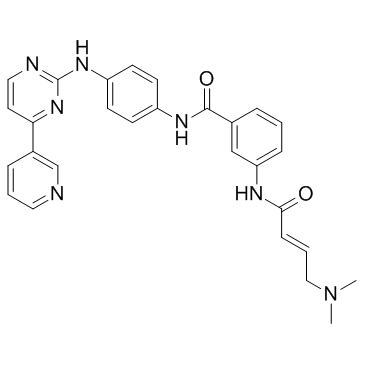JNK-IN-7
Modify Date: 2024-01-30 20:01:27

JNK-IN-7 structure
|
Common Name | JNK-IN-7 | ||
|---|---|---|---|---|
| CAS Number | 1408064-71-0 | Molecular Weight | 493.560 | |
| Density | 1.3±0.1 g/cm3 | Boiling Point | N/A | |
| Molecular Formula | C28H27N7O2 | Melting Point | N/A | |
| MSDS | N/A | Flash Point | N/A | |
Use of JNK-IN-7JNK-IN-7 is a potent JNK inhibitor with IC50 of 1.5, 2 and 0.7 nM for JNK1, JNK2 and JNK3, respectively. |
| Name | 3-{[(2E)-4-(Dimethylamino)-2-butenoyl]amino}-N-(4-{[4-(3-pyridinyl)-2-pyrimidinyl]amino}phenyl)benzamide |
|---|---|
| Synonym | More Synonyms |
| Description | JNK-IN-7 is a potent JNK inhibitor with IC50 of 1.5, 2 and 0.7 nM for JNK1, JNK2 and JNK3, respectively. |
|---|---|
| Related Catalog | |
| Target |
JNK3:0.7 nM (IC50) JNK1:1.5 nM (IC50) JNK2:2 nM (IC50) |
| In Vitro | JNK-IN-7 is a relatively selective JNK inhibitor in cells. In addition to JNK 1, 2, 3, JNK-IN-7 also binds to IRAK1(IC50=14.1 nM), YSK4 (IC50=4.8 nM), ERK3 (IC50=22 nM), PIK3C3, PIP5K3 and PIP4K2C[1]. Expression of divalent metal-ion transporter 1 (DMT1) in HCT116 is demonstrated to be markedly decreased under stimulation with TNF for 24 and 48 h, while JNK-IN-7 can significantly reverse the decrease. TNF can down-regulate DMT1 expression, while JNK-IN-7 can markedly suppress this function[2]. |
| Kinase Assay | A375 cells are pre-treated with 1 μM JNK-IN-7 for the indicated amounts of time. Remove the medium and wash 3 times with PBS. Resuspend the cell pellet with 1 mL Lysis Buffer (1% NP-40, 1% CHAPS, 25 mM Tris, 150 mM NaCl, Phosphatase Inhibitor Cocktail). Rotate end-to-end for 30 min at 4°C. Lysates are cleared by centrifugation at 14000 rpm for 15 min in the Eppendorf. The cleared lysates gel filtered into Kinase Buffer (0.1% NP-40, 20 mM HEPES, 150 mM NaCl, Phosphatase Inhibitor Cocktail, Protease Inhibitor Cocktail) using Bio-Rad 10DG colums. The total protein concentration of the gel-filtered lysate should be around 5-15 mg/mL. Cell lysate is labeled with the probe at 5 μM for 1 hour. Samples are reduced with DTT, and cysteines are blocked with iodoacetamide and gel filtered to remove excess reagents and exchange the buffer. Add 1 volume of 2X Binding Buffer (2% Triton-100, 1% NP-40, 2 mM EDTA, 2X PBS) and 50 μL streptavidin bead slurry and rotate end-to-end for 2 hours, centrifuge at 7000 rpm for 2 min. Wash 3 times with 1X Binding Buffer and 3 times with PBS. Add 30 μL 1X sample buffer to beads, heat samples at 95°C for 10 min. Run samples on an SDS-PAGE gel at 110V. After transferred, the membrane is immunoblotted with JNK antibody[1]. |
| Cell Assay | Intestinal epithelial cell line (HCT116) is cultured in DMEM medium, supplemented with 10% heat-inactivated fetal bovine serum (FBS), Penicillin (100 U/mL) and Streptomycin (100 g/mL), 2 mM L-gentamycin, and 50 μM 2-ME. These cells are stimulated with TNF (20 ng/mL), LPS (100 ng/mL), and IFN-γ (20 ng/mL), respectively. After 24 or 48 h of culture, cells are harvested followed by extraction of total RNA, and the levels of DMT1 mRNA are analyzed by qRT-PCR. To determine the mechanisms of TNF involved in regulating DMT1 expression, JNK-IN-7 (1 μM), NF-κB inhibitor (BAY 11-7082, 1 μM), and caspase-3/8 inhibitor (Z-DEVD-FMK, 50 μM) are also added into the culture medium. After 48 h of culture, cells are then collected to detect the expression of DMT1 by qRT-PCR[2]. |
| References |
| Density | 1.3±0.1 g/cm3 |
|---|---|
| Molecular Formula | C28H27N7O2 |
| Molecular Weight | 493.560 |
| Exact Mass | 493.222626 |
| LogP | 2.33 |
| Index of Refraction | 1.694 |
| Storage condition | 2-8°C |
| 3-{[(2E)-4-(Dimethylamino)-2-butenoyl]amino}-N-(4-{[4-(3-pyridinyl)-2-pyrimidinyl]amino}phenyl)benzamide |
| Benzamide, 3-[[(2E)-4-(dimethylamino)-1-oxo-2-buten-1-yl]amino]-N-[4-[[4-(3-pyridinyl)-2-pyrimidinyl]amino]phenyl]- |
| JNK-IN-7 |